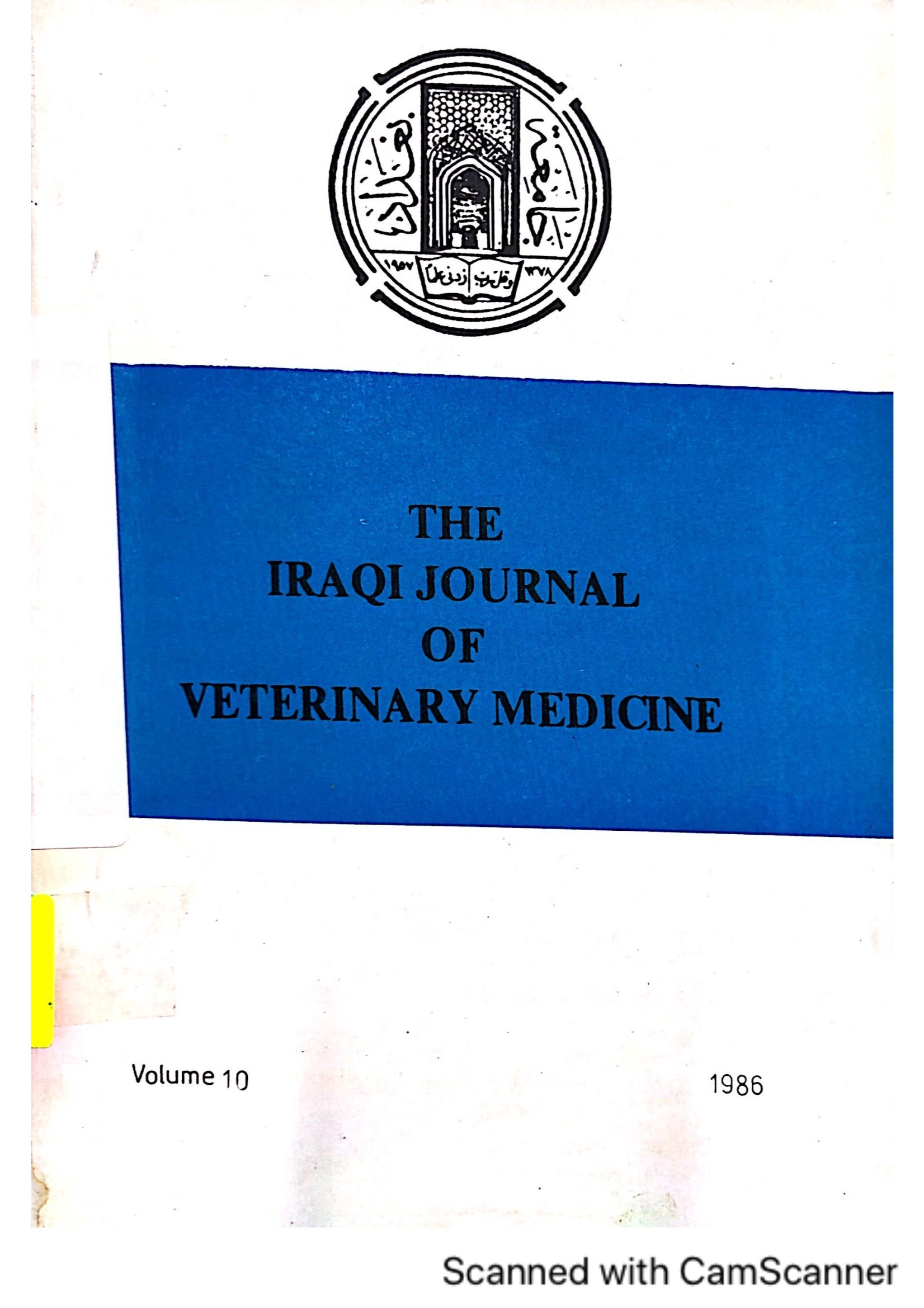Study of some Pathological Aspects in Sheep Infected with Fasciola gigantica
Main Article Content
Abstract
Little information is available on the pathophysiological changes caused by Fasciola gigantica. The present study aimed at the ellucidation of these changes in Awasi lambs infected with various doses (100, 300 and 600) of metacercariae.
The radio-isotop (Fe5%) was used to reveal the ferrokinetic pathway in the blood stream of sheep as a result of infection.
All lambs exposed to 100 metacercariae showed the chronic phase of the disease. Of the group exposed to 300 metacercariae, two lambs suffered the subacute phase and the remaining three had the chronic phase. Out of the five lambs given 600 metacercariae, four showed acute syndrom, while the fifth showed the subacute phase of the disease.
Blood picture in the acute phase showed severe anaemia of normochronic normocytic type while the anaemia in subacute and chronic phase of th disease was of hypochromic macrocytic type.
Using (Fe5%) revealed obvious increase in the amount of iron carried via plasma to the bone marrow, increased plasma iron clearance and rapid incorporation of iron in the newly formed red blood cells. These findings were pronounced in the chronic than in other forms of the disease.
Downloads
Article Details
Section
How to Cite
Publication Dates
References
Abdul Rahman, R.A.S. (1978). Studies on some aspects of Ovine fascioliasis in Iraq with particular reference to pathology and haematology of the disease due to Fasciola gigentica infection. M.Sc. Thesis, University of Baghdad.
Al Barwari, S.E. (1971). The role of carbohydrate in the biology of the liver fluke, Fasciols (Cobbold 1855). M.Sc. Thesis. University of Baghdad, pp.179.
Altaif, K.I. (1979). Effect of anthelmintic treatment on the preformance of Awassi sheep in Iraq. Trop. Anim. Hlth. Prod., 11, 241-245.
Berry, C.I. and Dargie, J.D. (1978). Pathophysiology of Ovine fascioliasis: The influence of dietary protein and iron on the erythrokinetics of sheep , experimentally infected with Fasciloa hepatica. Vet. Parasitology, 4 327-339.
Boray, J.C. (1967). Studies on experimental infections with Fasc patica with particular reference to acute fascioliasis in sheep. Ann. Trop. Med. Parasit., 61 :439-450.
Boray, J.C. (1969). Experimental fascioliasis in Australia in "Advances in Parasitology" Dawes, B. (Ed.) London and New York, Academic Press, 7, 95-210.
Bothwell, T.H. Hurtado, A.V., Donohue, D.M. and Finch, C.A. (1957). Erythrokinetics: IV-Plasma iron turnover as a measure of erythropoiesis. Blood, 12, 409-427.
Dargie, Fe Ds (1975). Applications of radioisotopic techniques to the study of red cell and plasma protein metabolism in helminth diseases of sheep. In:Pathogenic process in parasitic infections. A.E.R. Taylor and B.muller (Eds). Blackwell, Oxford, pp.1-26.
Dargie, J.D. and Mulligan, W. (1970). Ferrokinetic studies on normal and fluke infected rabbits. J. of Comp. Pathology 80, 37-45.
Davtyan, E.A. (1956). Pathogenicity of different species of Fasciola and its viability depending on the developmental conditions of the pathogenetic stages. Cited by Hammond, JA. (1973). Experimental chronic Fasciola gigantica infection in sheep. Trop. Anim. Hlth. Prod., 5, 12-21.
Grigoryan, G.A. (1953). The clicical course of acute fascioliasis in sheep caused by Fasciola gigantica. Cited by Hammond, J.A. (1973). Experimental chronic Fasciola gigantica infection in sheep. Trop. Anim. Hlth. Prod., 5, 12-21.
Guralp, N., Ozcan, C. and Simms, B.T. (1964). Fasciola gigantica and fascioliasis in urkey. Amer. J. Vet. Res., 25, 196-210.
Holmes, P.H., Dargie, J.D., Nackeabm H.M. and Mulligan, W. (1968). The anaemia in fascioliasis: studies with 51 Cr-labelled red cells. J. Comp. Path. 78, 415-420.
Hsu, H.F. (1939). China Med. J., 56, 122. Cited by Jennings, F .W. The anaemias of parasitic infections. In:Pathophysiology of parasitic infection. E.J.L. Solusby (Ed). Academic Press, New York, San Fransisco. London.pp.41-67.
Kendall, S.B. and parfitt, J.W. (1962). The Chemotherapy of Paaciolianin.: Brite Vet: J., 118; 1-10:
Mulligan, Ww. (1974). Raadio-Isotope techniques in pathophysioligical studies of helminthiasis. In:Helminth diseases of cattle, sheep and horses in Europe. G.M. Urquhart and J. Armour (Eds), Glasgow:Maclehose and Co. Ltd., pp.127-131.
Parfitt, J.W., Biol, M.T., A.I.S. T and Banks, A.W. (1970). A method for counting Fasciola eggs in cattle Faeces in the field. Vet. Rec. 87, 180-182.
Reid, J.F.S. (1973). Fascioliasis: Clinical Aspects and Diagonsis. In:."“Helminth deseases of cattle, sheep and horses in Europe"., G.M. Urquhart and J. Armour, (Eds). Glasgow: Robert Maclehose and Co., pp.81-86.
Reid, J.F.S., Armour, J., Jennings, F.W., and Urquhart, G.M. (1970). Studies on ovine fascioliasis. I. Observations on the sequantial development of the naturally acquired disease. Vet. Rec., 86, 242-249.
Roberts, H.E (1968). Observations on experimental acute Roseby, F.B. (1970). The effect of fascioliasis on the wool 365.
Ross, J.G., Dow, C. and Todd, J.R. (1967). A study of Fasciola hepatica infections in sheep. Vet. Rec. 80,543-546.
Schalm, O.W., Jainnic, and Carroll, E.J. (1975). (Veterinary Haematology). 3rd Ed., Lea & Febiger, Philadelphia p.15.
Sinclair, KB. (1962). Observations on the clinigal Pathology of ovine fascioliasis. Brit. Vet. J. 118,37-53.
Sinclair, K.B. (1965). Iron Metabolism in ovine fascioliasis. Brit. Vet. J., 121, 451-461.
Sogoyan, 1.8, -, (1968). Pathology and Pathogenesis of fascioliasis in sheep. Cited by Hammond, J.A. (1973). Experimental chronic Fasciola gigantica infection.Trop. Anim, Hlth. Prod., 5, 12-21.
Stephanson, W. (1947). hysiological and histochemical observations on the adult liver fluke,Fasciola hepatica. D. II Feeding. Parasitology, 38. 123-127.
Taylor, E.L. (1951). Cited by Sewell, M.M.B. (1966). The Pathogenesis of fascioliasis, Vet. Rec. 78, 98-105.
Todd, J.R. and Ross, T.G. (1966). Origin of haemoglobin in the caecal contents of Fasciola hepatica. Expi. Parasitol., 19, 151-154.
Urquhart, C.M. (1955). Experimental fascioliasis in the rabbit. Ph.D. Thesis. University of Glasgow.





